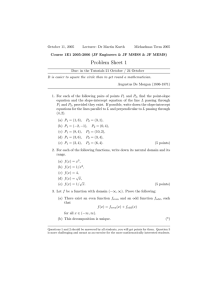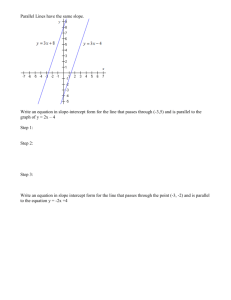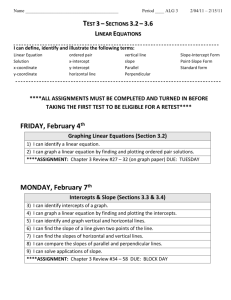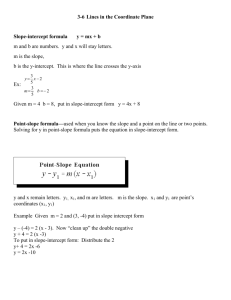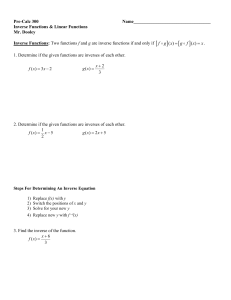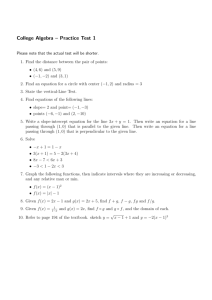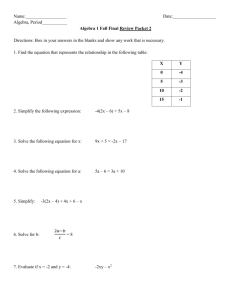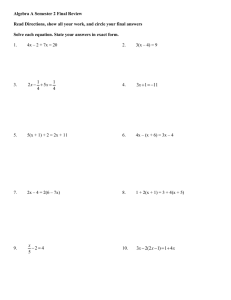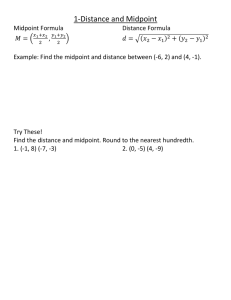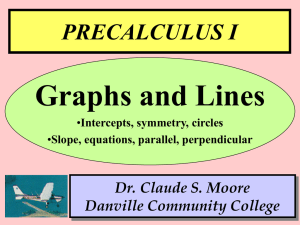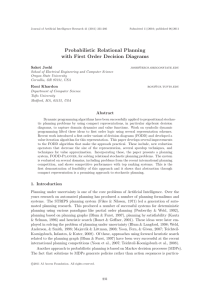Problem Sheet 1 – Solutions
advertisement
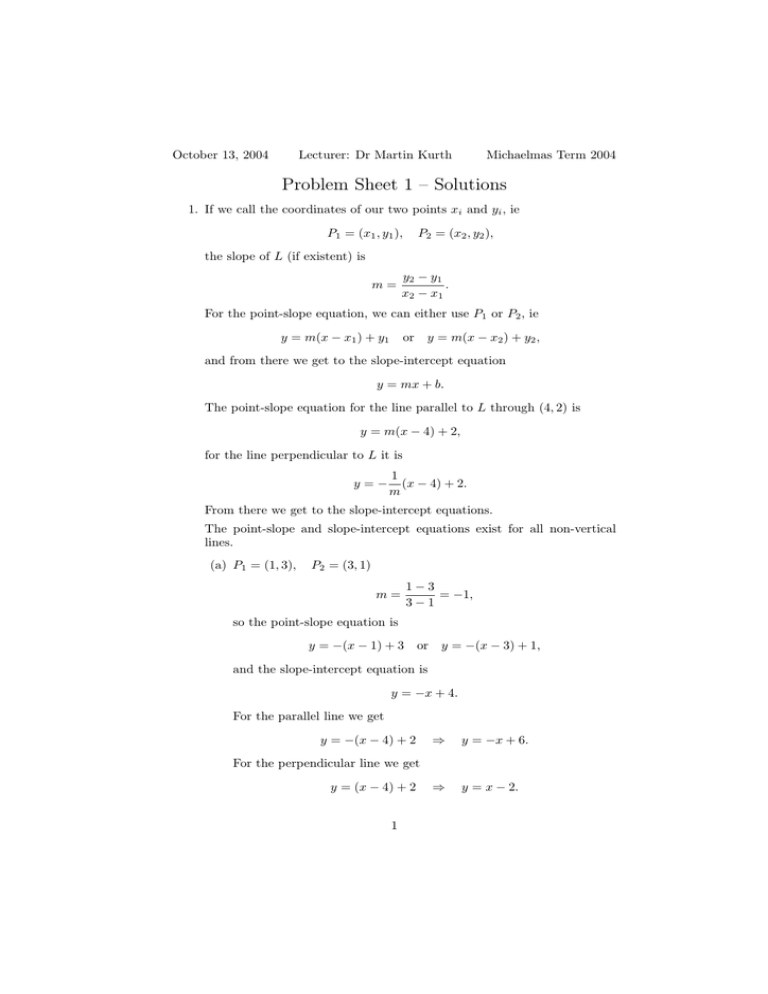
October 13, 2004
Lecturer: Dr Martin Kurth
Michaelmas Term 2004
Problem Sheet 1 – Solutions
1. If we call the coordinates of our two points xi and yi , ie
P1 = (x1 , y1 ),
P2 = (x2 , y2 ),
the slope of L (if existent) is
m=
y2 − y1
.
x2 − x1
For the point-slope equation, we can either use P1 or P2 , ie
y = m(x − x1 ) + y1
or
y = m(x − x2 ) + y2 ,
and from there we get to the slope-intercept equation
y = mx + b.
The point-slope equation for the line parallel to L through (4, 2) is
y = m(x − 4) + 2,
for the line perpendicular to L it is
y=−
1
(x − 4) + 2.
m
From there we get to the slope-intercept equations.
The point-slope and slope-intercept equations exist for all non-vertical
lines.
(a) P1 = (1, 3),
P2 = (3, 1)
m=
so the point-slope equation is
1−3
= −1,
3−1
y = −(x − 1) + 3 or y = −(x − 3) + 1,
and the slope-intercept equation is
y = −x + 4.
For the parallel line we get
y = −(x − 4) + 2
⇒
y = −x + 6.
⇒
y = x − 2.
For the perpendicular line we get
y = (x − 4) + 2
1
(b) P1 = (−2, −1),
P2 = (0, 4)
m=
4+1
5
= .
0+2
2
Point-slope equation:
y=
5
(x + 2) − 1 or
2
y=
5
5
(x − 0) + 4 = x + 4..
2
2
Slope-intercept equation:
y=
Parallel line:
y=
5
x + 4.
2
5
5
(x − 4) + 2 = x − 8.
2
2
Perpendicular line:
2
2
18
y = − (x − 4) + 2 = − x + .
5
5
5
(c) P1 = (8, 4),
P2 = (10, 2)
m=
2−4
= −1.
10 − 8
Point-slope equation:
y = −(x − 8) + 4
or y = −(x − 10) + 2.
Slope-intercept equation:
y = −x + 12.
Parallel line:
Perpendicular line:
y = −(x − 4) + 2 = −x + 6.
y = (x − 4) + 2 = x − 2.
Alternatively, you can argue that the slope of L is the same as in (a),
so the parallel and perpendicular lines through (4, 2) have to be the
same as in (a) too!
(d) P1 = (3, 6), P2 = (3, 4) This line is vertical, so it has no slope, and
we can’t write down any point-slope equation or slope-intercept equation for L. The same applies to the parallel line through (4, 2). But
we can write down the slope-intercept equation for the perpendicular
line through (4, 2). It is the horizontal line with
y = 0x + 2 = 2.
2
(e) P1 = (2, 4),
P2 = (6, 4)
m=
Point-slope equation:
4−4
= 0.
6−2
y = 0(x − 2) + 4 = 4 or y = (x − 6) + 4 = 4.
Slope-intercept equation:
y = 0x + 4 = 4.
Parallel line:
y = 0x + 2 = 2.
The perpendicular line through (4, 2) is vertical, so we can’t write
down any slope-intercept equation for it!
2. Denoting the natural domain of f with D, and the Range with R we get
(a) f (x) = x3
D = R = (−∞, ∞)
R = R = (−∞, ∞)
(b) f (x) = 1/x2
D = R \ {0} = (−∞, 0) ∪ (0, ∞)
R = (0, ∞)
(c) f (x) = 4
D = R = (−∞, ∞)
R = {4}
√
(d) f (x) = x
D = [0, ∞)
R = [0, ∞)
√
(e) f (x) = 1/ x
D = (0, ∞)
R = (0, ∞)
3. (a) We can prove the existence of feven and fodd by construction:
feven (x)
=
fodd (x)
=
1
(f (x) + f (−x)) ,
2
1
(f (x) − f (−x)) .
2
We can easily check that
feven (−x) =
and
fodd (−x) =
1
(f (−x) + f (x)) = feven (x)
2
1
(f (−x) − f (x)) = −fodd (x).
2
3
(b) We can prove the uniqueness of the decomposition by contradiction.
Let us assume that two different functions feven,1 and feven,2 , and
two different functions fodd,1 and fodd,2 exist, such that
f (x) = feven,1 (x) + fodd,1 (x) = feven,2 (x) + fodd,2 (x)
for all x ∈ (−∞, ∞). Let us now introduce two new functions
geven (x) = feven,1 (x) − feven,2 (x)
and
godd (x) = fodd,1 (x) − fodd,2 (x).
We know that
geven (x) + godd (x) = f (x) − f (x) = 0
for all x ∈ (−∞, ∞), ie we also know that
geven (−x) + godd (−x) = 0
for all x ∈ (−∞, ∞). As geven is the difference of two even functions
it is even, and as godd is the difference of two odd functions it is odd.
This means that the last equation can be rewritten as
geven (x) − godd (x) = 0
For all x ∈ (−∞, ∞). Combined with
geven (x) + godd (x) = 0
this gives us
geven (x) = godd (x) = 0
for all x ∈ (−∞, ∞), ie
feven,1 (x) = feven,2 (x)
and fodd,1 (x) = fodd,2 (x),
contrary to the assumption that these pairs of functions are different. Thus the assumption must be wrong, and our decomposition is
unique.
4
